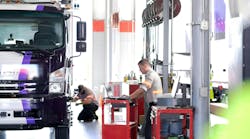At the 38th annual American Truck Dealers convention, Michel Gigou of Mack Trucks Inc., James L. Hebe of Freightliner LLC, John R. Horne of Navistar International Corp., and James C. Underwood of GM Isuzu Commercial Truck all said big change is ahead for the truck manufacturing sector. Consolidation, globalization, the Internet and other factors will alter what the truck-making industry will look like in the years ahead, they said.
“Consolidation and globalization will touch every level of our industry – suppliers, manufacturers, and users alike,” said Gigou, president of Mack Trucks. “The reasons are the same for all of us – the truck-making business is capital-intensive, is extremely competitive, and is heavily affected by regulations.”
Gigou said the substantial benefits of consolidation and globalization include economies of scale, improved product quality and performance, and better time-to-market at a more competitive price.
This level of change will also alter the OEM-dealer relationship, Gigou added, but in a way that will strengthen their reliance upon one another.
“It will be a partnership, more focused on the customer, because our profits will be linked together by building a better quality product and delivering it through a better distribution network,” he said.
Hebe, Freightliner’s president and CEO, pointed out that the parts business of both dealers and OEMs may be threatened in the future unless they work more closely together.
“Class 6 through 8 truck parts are a $12 billion industry – $9.6 billion at dealer net,” he said. “But we are in a declining parts market as part of the consequences of consolidation.”
He said that the industry “dodged a big bullet” with the fall of Internet-based parts providers.
“Though dot.com parts providers failed, they left behind some valuable lessons: Well-stocked parts inventory located as close to the customer as possible is the ideal and that parts information is no longer proprietary,” he said. “Fleets want consistency from their parts suppliers so we must rewrite how we do business with them.”
Horne, CEO of Navistar, said the way trucks are developed must and will change. No longer can trucks be a “compilation of parts” put together on a specification sheet. Every component of a truck – engine, transmission, axles, and electronics – must be integrated together into a single, smooth-operating package.
“We must develop, match and optimize all the components on a truck so good ride handling goes up and fuel consumption goes down,” he said. “That means we must change how we design and develop trucks with our vendor partners.”
Underwood, president and COO of GM Isuzu, said that how OEMs and dealers view the truck market must change as well. In the future, light-, medium-, and heavy-duty truck market segments must all be viewed and serviced individually, not grouped together and marketed to as a single entity.
“They are each separate businesses, not necessarily linked together,” he said. “Dealers must go after each segment with all their resources – new and used truck sales, service, parts, and financing – so no money is left on the table.” Underwood said he believes Class 3 through 7 sales, in particular, will grow strongly over the next five years. He said higher levels of service and support will be required for those markets.


